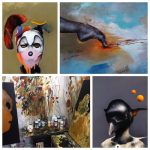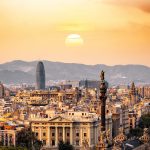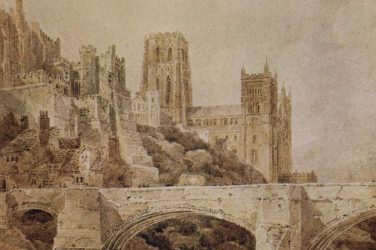The conflict in Donbas has been going on for three years. Hostilities, violence and human rights violations have left indelible traces in Ukrainian society.
Already, more than 10,000 people have lost their lives. Over 200,000 children need psychological treatment in order to cope with the dramatic changes in living conditions and the associated trauma they are suffering.
But these are just numbers and figures. Statistics do not help tell the stories of those scarred by the fighting.
The war in Eastern Ukraine has drastically changed the lives of the people there. To convey the difficult situation throughout Ukraine and in other countries, methods and media must be developed in order to reach different groups.

A new media representation of the Donbas war
In response to the need for new representations of the war, a group of civil society activists and artists worked together to create a graphic novel about fear and hardship, choices and hopes.
They interviewed people and collaborated with artists to form a graphic novel of comic strips that told how the nine people interviewed suffered violence and human rights violations.
The novel is handed out free-of-charge with the hope to expose the realities of the war.
The project, initiated by Libereco and the Coalition “Justice for Peace in Donbas”, aims to give the victims of the violence a voice.
E&M caught up with project coordinator Dr. Imke Hansen to find out more.

E&M: Why a graphic novel?
We chose to tell these stories in comic form, altogether making a so-called graphic novel. Graphic novels tell stories both with words and pictures. They can speak more directly to people than books and reports do, communicating things you cannot say with words, explaining complex matters without long texts, and refraining from judgement and one-sided/black-white pictures.
They enable us to empathize with the people in the story, and to see the world through their eyes. We consider the graphic novel as an excellent medium to speak about violence, hardship and human rights violations.
Moreover, the comic form enabled us to actually create something together, with interviewees, trainers, authors and artists involved, with controversial discussions, difficult decisions and a lot of cooperation.
Making the graphic novel taught us to talk about the conflict, even if we do not agree, and even if we do not understand everything.
E&M: How powerful is the tool of the graphic novel in conveying such a difficult topic to a wider audience?
Graphic novels reach a different audience to mainstream news. They speak to the young generation, and are consumable by people who would not read reports or other text formats.
Graphic novels have the great potential to provide very special access to historically and politically difficult topics. The medium allows the reader deep insights into the protagonists and is therefore capable of showing various views and levels.
E&M: What does the novel hope to achieve?
When we read about violence in Donbas, we usually read numbers: casualties, shelling frequency, IDPs. Often we also read places: Checkpoints, borders, fighting spots.
Reports rarely reveal how the human beings that are exposed to violence feel, how they deal with it and how it impacts their lives. In current media, there seems to be little place for their stories, and even less for their voices.
Our project attempts to change that. We wanted to show the variety of ways conflict produces violence. We wanted to tell authentic stories of people who were, and are, exposed to violence.
By means of these stories, we want to show what the conflict actually means for people, how it changes their lives, and thus, how it impacts society.
Such an enterprise requires a powerful team.
We invited people from various Ukrainian organisations who are involved with conflict documentation to participate. They would become our authors. Moreover, we found two skilled artists that were ready to engage in a group process. They would draw the stories and hence create not only a piece of information but also a piece of art.
E&M: Do you think the novel will lead to more people sharing their experiences of the war?
That has already happened, and it is very possible that it will happen again. In general, people feel safer to share their experiences when they have a framework for it, when there are similar stories that make their story sound believable.
E&M: How do visual representations help to convey the violence suffered?
It is difficult to talk about violence. We want to be empathetic, convey the drastic rupture, but not feed into voyeurism. The graphic novel has the capacity to do so, as it is an artistic form linking text and image in a creative way and leaving a lot of room for imagination for the reader.
E&M: Do we, as Europeans, get enough exposure to what happened? Are we detached/desensitised from it in some sense?
In 2014, the war in Donbas was quite present in German media. However, for more than a year German media hardly reports about the war in Donbas at all.
Probably the situation is not much different in other Western European countries. Media coverage very much concentrates on war activity. The everyday life of people in the warzone, and the life of those affected by the war, does not receive any attention of a broader audience in the west.

E&M: Who inspired the graphic novel, and why?
We were inspired by the people who suffer from the war, and whose voices are not heard, whose stories are not told.
Many people are interviewed to gain data for statistics, or future court procedures. But behind every number, there are personal stories of loss, violence, forced migration, hardship and struggle. These stories should not be overheard or forgotten as they constitute the face of war.
E&M: How does the graphic novel manage to accurately reflect the multifaceted and complex nature of war?
It conveys the complex nature of war by integrating image and word, facts and feelings, by portraying daily life in the war zone, and in a country that is at war. Moreover, by displaying that all the people in the conflict area constantly face very difficult decisions, with very harsh consequences.
E&M: What is Oral History?
At the beginning of the project, we trained the authors how to do biographical interviews. These interviews do follow the question-answer scheme. They give the respondent the freedom to tell their stories the ways they want, in their pace and their words, without interruption or guidance.
That method, called Oral History, makes the story truly theirs, and not simply reactions to an interviewer. It was designed to give people a voice who are usually not heard. It produces authentic accounts of events that reproduce the situation the way the respective person has experienced it.
These accounts help to understand not only what happened, but what it meant to a person – how the person felt, thought, and decided in a certain situation. Rather than producing dates, facts and numbers, Oral History tells stories of dreams and fears, of difficult decisions and their consequences, of friends and foes, in a nutshell: of life.
It reveals how experiences affect us, and change us.
Every author asked a person they knew to give a biographical interview. After these interviews were conducted, the team met and started to transform the interview into a comic strip. We chose one story from each interview that displays the different ways how people got involved with the conflict, how they were exposed to violence, and how that changed their lives.
About the interviewee
Dr. phil. Imke Hansen is a historian specializing in Memory Studies, Eastern European and Oral History, and is a human rights activist.
Combining theory and practice, she strives to enhance dialogue and discourse about experiences of loss and violence in society.











